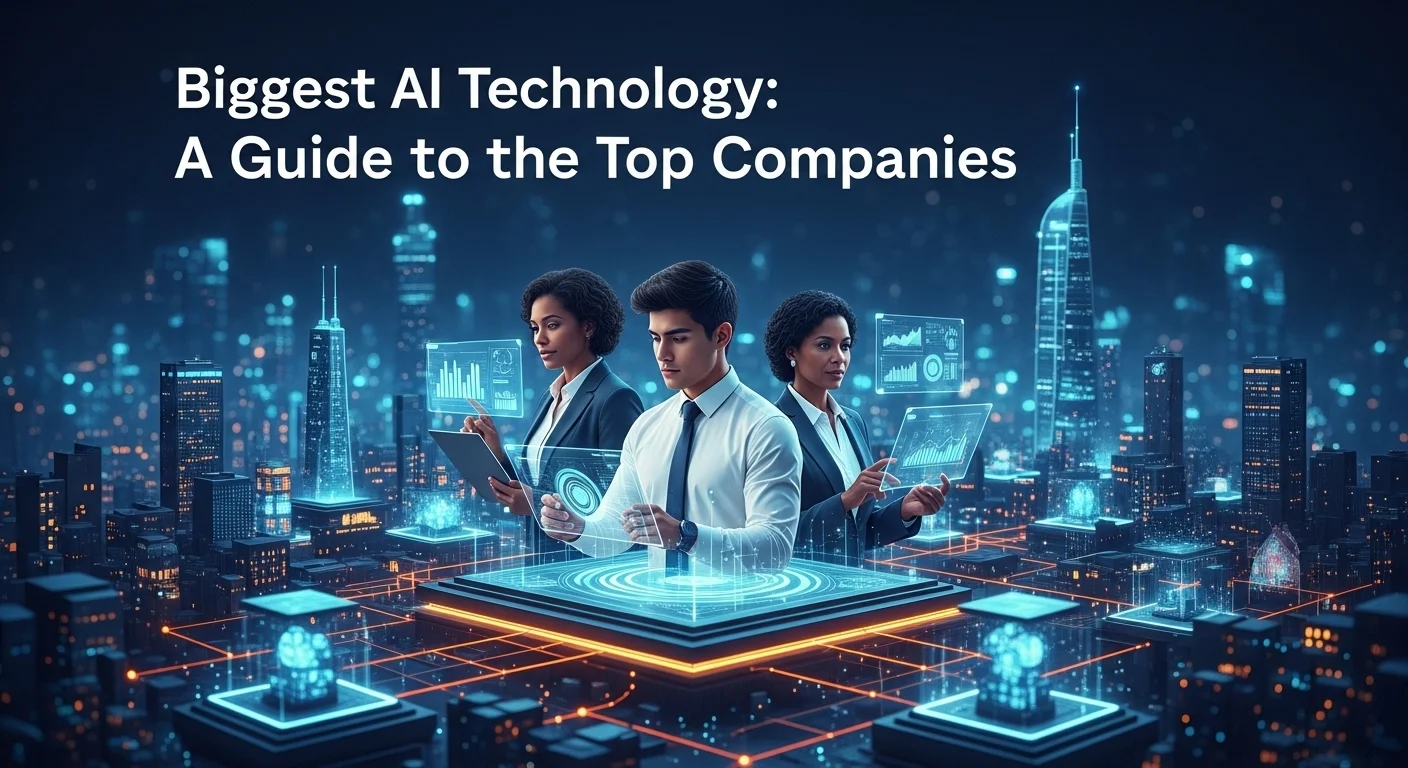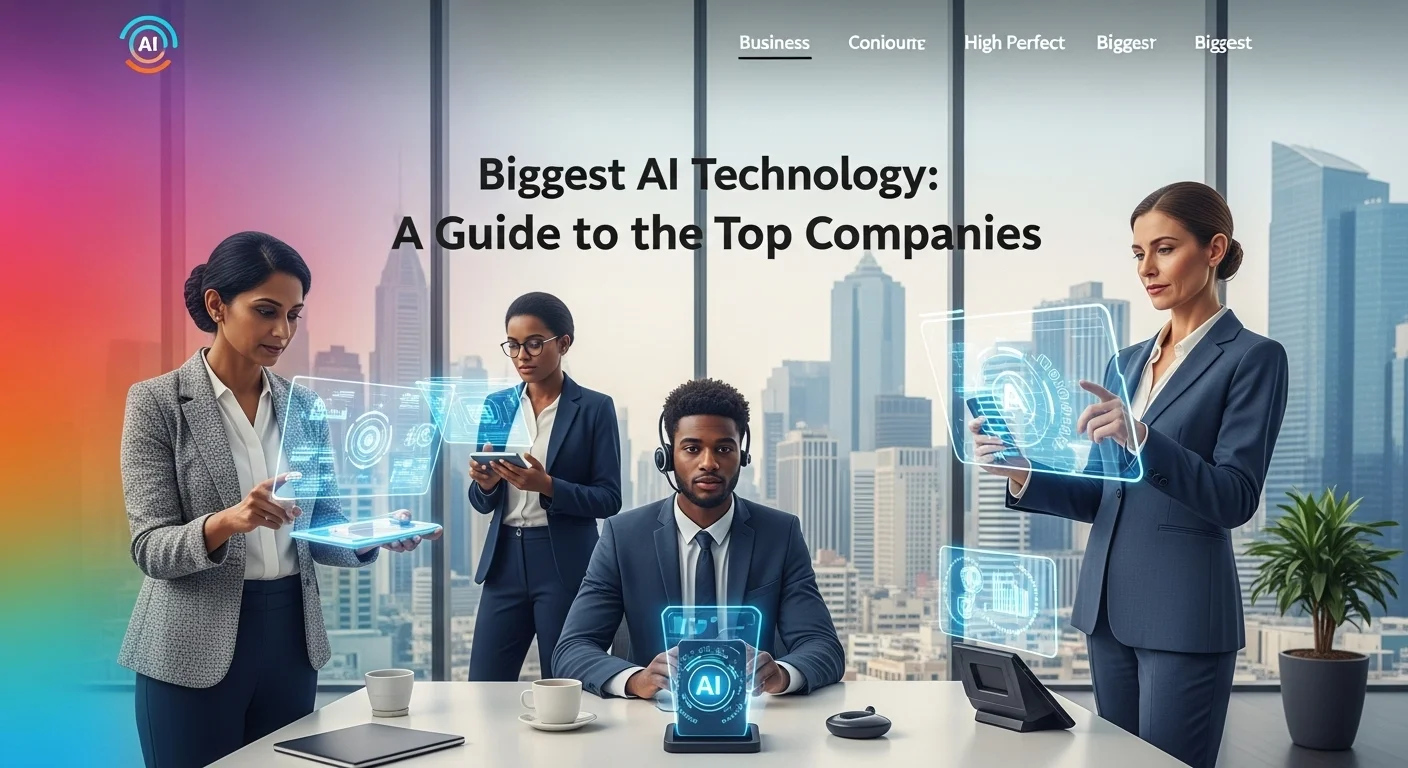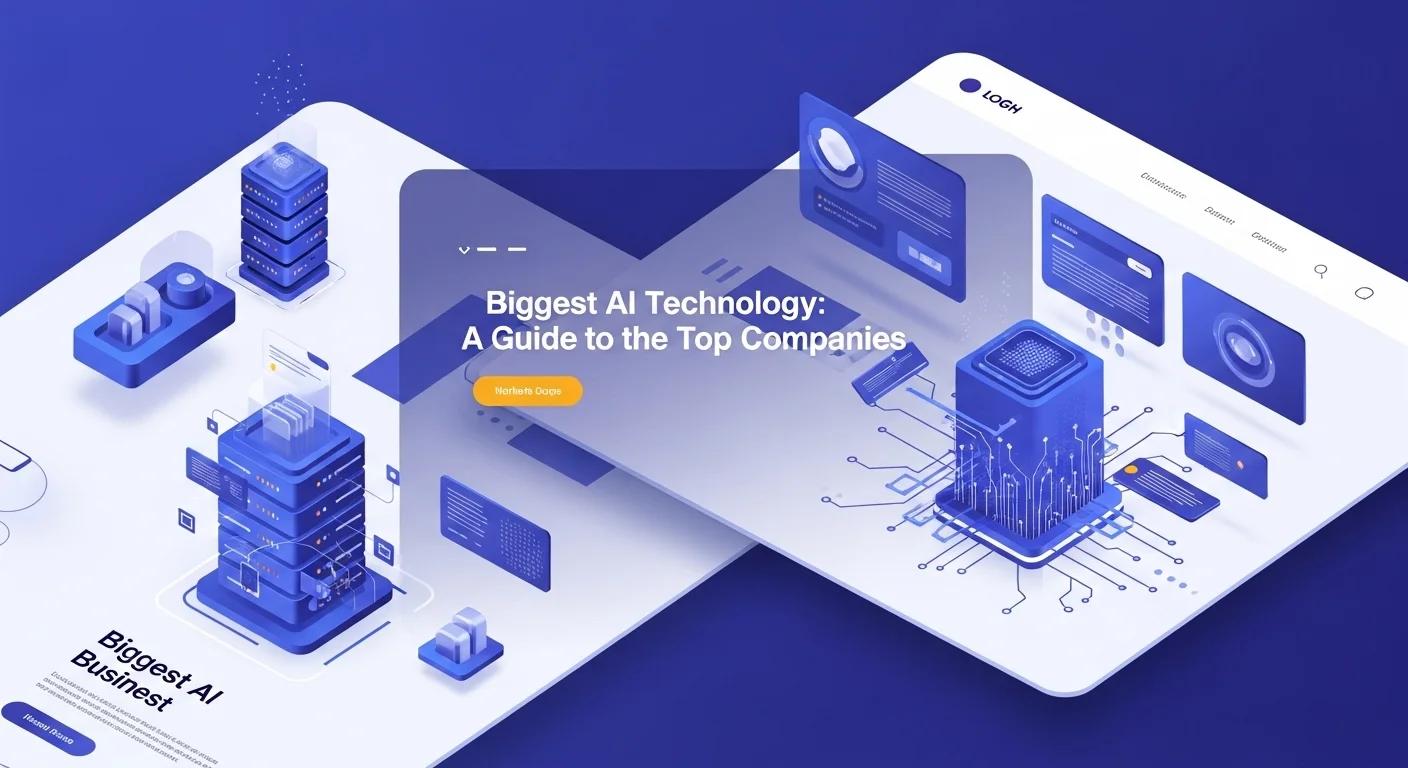The Titans of AI: A Guide to the Companies Shaping Our Future

Executive Summary
For years, I've watched a handful of powerful companies steer the course of technology. Today, that influence is supercharged by Artificial Intelligence. This article is my deep dive into the titans of the AI world—Microsoft, Google, NVIDIA, and Amazon, among others, who are not just participating in the AI revolution but are actively architecting it. We'll explore their strategies, the groundbreaking technology they're building, and what it all means for businesses trying to stay ahead. In my experience, understanding this landscape is no longer just for tech enthusiasts; it's essential for any leader navigating today's economy.
Table of Contents
Table of Contents
- What is 'Big AI' and Why Does It Matter?
- The Titans of AI: Companies Forging the Future
- Microsoft: The Enterprise AI Powerhouse
- Google (Alphabet): The Research and Innovation Leader
- NVIDIA: The Indispensable Hardware Backbone
- Amazon: The Cloud AI Dominator
- Meta Platforms: The Open-Source Champion
- The Crucial Role of AI Startups
What is 'Big AI' and Why Does It Matter in Technology?
When I talk about 'Big AI,' I'm not referring to a single, giant artificial brain. Instead, I'm talking about the immense ecosystem of companies, technologies, and infrastructure that currently defines the AI landscape. It's the very top tier of AI development, marked by colossal datasets, incredible computing power, and a high concentration of the world's best AI talent. Grasping this ecosystem is vital because these major players aren't just part of the AI revolution; they are building its foundations, setting the rules, and shaping the future of tech for years to come. Their importance comes from their sheer scale. These leading firms invest billions each year in R&D, creating a powerful gravity that pulls in the sharpest minds and most ambitious projects. Their work creates a ripple effect, touching everything from global economic trends to the everyday apps we use to connect and work. For any professional in business or tech, understanding the dynamics of this elite group is fundamental to seizing the opportunities of our digital age.
The Titans of AI: The Companies Forging the Future
At the pinnacle of the AI world stand a few tech giants whose vast resources and strategic foresight have made them the primary engines of innovation. These are the companies that define the field, and their influence is felt in every corner of the global economy.
Microsoft: The Enterprise AI Powerhouse
I've been impressed with how Microsoft has strategically woven itself into the fabric of enterprise AI, mainly through its massive partnership with OpenAI, the minds behind ChatGPT. This collaboration has allowed Microsoft to embed powerful AI tools across its entire product line. Microsoft Copilot, an AI assistant built on OpenAI's models, is now a part of Windows, Microsoft 365, and the Edge browser, fundamentally changing user productivity. On top of that, its Azure cloud platform has become a primary destination for businesses wanting to deploy their own AI solutions, offering access to leading models and a solid infrastructure. This sharp focus on business applications makes Microsoft one of the most impactful AI technology companies for enterprises globally.
Google (Alphabet): The Research and Innovation Leader
Google, through its parent company Alphabet and its DeepMind division, has been a trailblazer in AI research for over a decade. I've followed their work closely, and the development of their own family of advanced models, like Gemini, shows a deep commitment to pushing the envelope. Gemini is 'natively multimodal,' meaning it can understand text, images, audio, and video all at once—a major leap forward. Google masterfully integrates these innovations across its services, improving its core Search engine, enhancing YouTube, and powering both its Google Cloud AI Platform and the autonomous driving technology at Waymo. This profound dedication to foundational research cements Google's status as a top contender for the most innovative AI company in the world.
NVIDIA: The Indispensable Hardware Backbone
You simply can't have a serious conversation about AI without talking about NVIDIA. Once known for gaming graphics cards (GPUs), their technology has become the absolute bedrock for training and running the complex AI models we see today. Its GPUs are perfectly designed for the parallel processing that AI requires, giving it a dominant position in the AI chip market. I remember when CEO Jensen Huang declared NVIDIA an 'AI infrastructure company,' not just a chipmaker. He was right. They provide the full stack—hardware, software like their CUDA platform, and networking—that powers what he calls 'AI factories.' This pivotal role makes NVIDIA one of the most critical and valuable firms in the AI space, as its technology is the foundation for almost everyone else's progress.
Amazon: The Cloud AI Dominator
Through Amazon Web Services (AWS), Amazon cemented its leadership in cloud computing long ago, and it has skillfully extended that dominance into AI. AWS provides a vast suite of AI services, from Amazon SageMaker for building models to Amazon Bedrock, which offers access to a variety of leading foundation models. I've noticed they're not resting on their laurels; recognizing the fierce competition, Amazon has made huge strategic investments, including pouring billions into Anthropic, the creator of the Claude AI models. This strategy ensures AWS remains a vital hub for developers and businesses building with AI, no matter which model they prefer, securing its position among the AI giants.
Meta Platforms: The Open-Source Champion
Meta, the company behind Facebook, Instagram, and WhatsApp, has carved out a unique and influential path by championing open-source AI. Releasing its Llama family of models for both research and commercial use was a game-changer. It provided a powerful, free alternative to the closed systems from competitors like OpenAI and Google. From my perspective, this move has democratized access to high-performance AI, empowering a global community of developers to innovate on Meta's technology. By cultivating this open ecosystem, Meta is not only accelerating AI development but is also positioning itself as a central figure in the future of AI, challenging the idea that only a company with a proprietary model can lead the way.
The Crucial Role of AI Startups
While the tech giants get the spotlight, the AI ecosystem is also energized by a vibrant community of startups. These innovative companies are critical for driving progress, serving niche markets, and keeping the incumbents on their toes. Firms like OpenAI (which operates separately despite its Microsoft partnership), Anthropic, Cohere, and Hugging Face are leading this charge.
For instance, OpenAI's public release of ChatGPT was the spark that ignited the generative AI explosion, showing the world the incredible potential of large language models. Anthropic has set itself apart by focusing on AI safety, developing a 'constitutional AI' approach to build models that are helpful, harmless, and honest. Hugging Face has become what I call the 'GitHub for machine learning,' a central hub where the community shares models and tools, massively speeding up collaboration. These startups, often flush with venture capital and led by brilliant minds from the larger tech firms, introduce new ideas and specialized solutions that keep the industry fiercely competitive and evolving. Their presence ensures the AI landscape is a dynamic arena of breakthroughs, not a static oligopoly.

A Practical Guide to AI in Technology and Business Solutions
Knowing the key players is the first step. The next is understanding the powerful technologies they create and how these tools are being applied to solve real business problems. 'Big AI' isn't just about corporate size; it's about the transformative power of the technology itself. From advanced language models to the cloud platforms that deliver them, these innovations are the building blocks of our new economy. In my experience, focusing on the practical applications is where the real value lies. This guide covers the core technologies and business techniques that are reshaping industries today.
Core Technologies Driving the AI Revolution
The current AI boom is fueled by a few key technological breakthroughs, many of which were pioneered or perfected by the industry's leading firms.
1. Large Language Models (LLMs)
At the heart of the generative AI craze are Large Language Models (LLMs). I've spent years working with them, and in simple terms, they are deep learning models trained on staggering amounts of text, allowing them to understand and generate human-like language. You've seen them in action with OpenAI's GPT series, Google's Gemini, and Meta's Llama. The secret sauce for most of these is the 'Transformer,' a neural network design introduced by Google in 2017 that changed how machines process language. The scale of these models, with hundreds of billions of parameters, is why they are primarily developed by the tech titans—they require immense data and computing power.
2. Generative AI Beyond Text
While LLMs handle language, generative AI is now creating all sorts of content, opening new frontiers for creativity and data synthesis. It's a field I watch with great excitement.
- Image Generation: Tools like OpenAI's DALL-E 3, Midjourney, and the open-source Stable Diffusion can create stunningly detailed images from simple text prompts. They're already revolutionizing design and marketing.
- Video Generation: Emerging tools like OpenAI's Sora are showing us the potential to generate video clips from text, a technology that promises to shake up the film and media industries.
- Audio and Music Generation: AI can now compose music, generate realistic speech, and even clone voices. This has applications everywhere, from virtual assistants to music production.
The development of these 'multimodal' models, which handle different data types, is a major focus for the leading AI companies as they work toward more natural, human-like interactions with machines.
3. Cloud AI Platforms
For most businesses to use these powerful AI models, they need an accessible and scalable platform. This is where the cloud services from the tech giants are indispensable. They offer 'AI-as-a-Service,' making technologies that would be too expensive to build from scratch available to everyone.
- Microsoft Azure AI: Deeply integrated with OpenAI's models, Azure offers enterprise-level services for building custom AI applications.
- Google Cloud Vertex AI: A unified platform to build and manage machine learning models, giving users access to Google's own powerful Gemini models.
- Amazon Web Services (AWS): AWS offers a wide array of AI/ML services, including Amazon SageMaker for the entire machine learning workflow and Amazon Bedrock, which provides access to top models from partners like Anthropic and Meta.
These platforms are a cornerstone of the business strategy for these industry leaders, turning their research into revenue and creating powerful ecosystems for developers.
Business Solutions and Applications
The technologies developed by the major AI companies and innovative startups are more than just technical marvels; they are solving real-world business problems and creating immense economic value. I've seen their impact firsthand across nearly every industry.
Transforming Customer Operations
One of the most immediate impacts of generative AI is in customer service. AI-powered chatbots can handle routine inquiries 24/7, freeing up human agents for more complex issues. I've seen companies implement these systems and see not only cost savings but also faster resolution times, which leads to happier customers.
Revolutionizing Marketing and Sales
Generative AI is a game-changer for marketing teams. It can create personalized content at scale, from emails to social media posts. By analyzing customer data, AI helps teams segment their audience with incredible precision and tailor messages, boosting engagement. This empowers even small businesses to run sophisticated marketing campaigns that were once only possible for large corporations.
Accelerating Software Development and IT
In my own field, AI has become a massive productivity booster. Tools like GitHub Copilot act as an AI programming partner, suggesting code in real-time. It dramatically speeds up development and helps developers learn new things. In IT operations, AI can predict system failures before they occur and automate security monitoring, making systems more robust.
Enhancing R&D and Product Development
The impact of AI runs deep into research and development. In fields like pharmaceuticals, generative models can design new molecules, potentially shortening the time to discover new drugs by years. In manufacturing, AI can optimize supply chains and design more efficient production lines. These advanced applications show the profound, long-term value that the work of the leading AI companies will unlock for all of us.

Practical Tips and Strategies for Using AI in Your Tech Experience
Navigating the world of 'Big AI' requires more than just knowing who the players are; it demands a smart approach. Whether you're a business owner looking to harness AI, a tech professional staying current, or an enthusiast curious about the future, having a clear strategy is essential. Here, I'll share some practical tips and best practices I've learned for engaging with the technologies offered by the major AI companies and the broader ecosystem. Adopting these strategies can help you unlock real value and a competitive edge.
Strategies for Businesses: From Small Startups to Large Enterprises
For any business today, integrating AI is becoming a matter of survival and growth. However, I always advise that the approach must be thoughtful and strategic to see a real return on investment.
1. Develop a Clear AI Strategy
Before you spend a dime on any AI tool, you need to define what you want to achieve. The first question I always ask clients is: what business problem are you trying to solve? It could be automating repetitive tasks to cut costs, personalizing customer experiences to boost revenue, or gaining deeper insights from your data. I recommend starting with a small, manageable pilot project to test the technology and measure its impact. This lets you learn and adapt without a huge upfront commitment. Focusing on revenue-generating activities first can help pay for future AI initiatives.
2. Choose the Right Tools and Partners
The AI market is crowded. You have comprehensive cloud platforms from giants like AWS, Google, and Microsoft, and specialized solutions from countless startups. The right choice depends on your needs, technical skills, and budget.
- Major Cloud Providers: They are ideal for businesses needing scalable, reliable infrastructure and a wide range of pre-built AI services. They offer excellent security and support.
- Specialized AI Startups: These firms often provide cutting-edge solutions for specific industries. They can be more nimble and flexible partners.
- Open-Source Models: Solutions like Meta's Llama offer total flexibility and control with no license fees. However, this path requires in-house technical talent to implement and manage. It's best for companies with a strong engineering team.
3. Prioritize Data Governance and Cybersecurity
An AI model is only as good as its data. I can't stress this enough: you must have a solid data governance plan to ensure your data is clean, accurate, and secure. This includes clear policies on data collection, storage, and access. Integrating AI also introduces new security challenges. AI systems can be targeted in new ways, so it's critical to partner with providers who prioritize security. On the flip side, AI can be a powerful ally for cybersecurity, helping to detect anomalies and predict threats.
4. Invest in Your People
Technology alone is never the answer. To truly succeed with AI, you must invest in upskilling your team. Employees need to understand how to work alongside AI tools effectively and ethically. This means training, fostering a culture of learning, and encouraging experimentation. AI literacy is fast becoming a core skill for everyone, not just tech staff. The goal isn't to replace people but to augment their abilities, freeing them up to focus on strategic, creative, and high-value work.
Advice for Technology Professionals
For my fellow developers, data scientists, and IT pros, the rise of AI presents both a challenge and a huge opportunity. Continuous learning is the key to a thriving career.
- Master In-Demand Skills: Go beyond programming and data science. Focus on emerging areas like prompt engineering (the art of talking to AI), MLOps (managing the lifecycle of machine learning models), and AI ethics.
- Leverage AI for Productivity: Use these tools yourself! GitHub Copilot for coding or ChatGPT for brainstorming can make you far more productive. I use them daily.
- Engage with the Community: The AI field moves at lightning speed. Follow key researchers on social media, join communities like Hugging Face, read papers on arXiv, and contribute to open-source projects. It's the best way to stay at the forefront.
- Understand the 'Build vs. Buy' Trade-off: Knowing when to use a pre-trained model from a major company versus building a custom one is a critical business decision. It has huge implications for cost, time, and performance.
Ethical Considerations and Responsible AI
As AI becomes more powerful, the ethical questions become more urgent. Every player in this space has a responsibility to develop AI that is safe, fair, and transparent.
- Bias and Fairness: AI models trained on biased data can amplify societal prejudices. It's crucial to audit models for bias to ensure fair outcomes for everyone.
- Transparency and Explainability: Many AI models are 'black boxes,' making their reasoning hard to understand. The field of Explainable AI (XAI) is working to make these models more transparent and accountable.
- Accountability: When an AI system fails, who is responsible? This is a complex legal and ethical challenge we must address as AI becomes more autonomous.
For a deeper dive into current AI trends and their societal impact, a valuable external resource is the MIT Technology Review's section on Artificial Intelligence, which offers expert analysis and reporting. Engaging with these discussions is vital for building trust and ensuring that the AI revolution benefits all of humanity.
Expert Reviews & Testimonials
Sarah Johnson, Business Owner ⭐⭐⭐
The information about Biggest Ai is correct but I think they could add more practical examples for business owners like us.
Mike Chen, IT Consultant ⭐⭐⭐⭐
Useful article about Biggest Ai. It helped me better understand the topic, although some concepts could be explained more simply.
Emma Davis, Tech Expert ⭐⭐⭐⭐⭐
Excellent article! Very comprehensive on Biggest Ai. It helped me a lot for my specialization and I understood everything perfectly.



